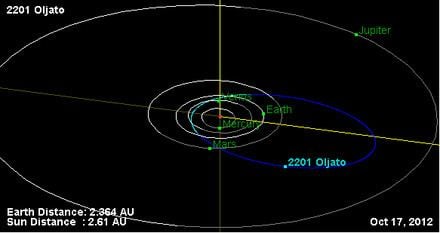Discovered by H. L. Giclas MPC designation 2201 Oljato Discovered 12 December 1947 Orbits Sun | Discovery date 12 December 1947 Aphelion 3.73 m | |
 | ||
Alternative names 1947 XC · 1979 VU21979 XA Similar 4183 Cuno, Sun, Solar System, 3362 Khufu, 1865 Cerberus | ||
2201 Oljato, provisional designation 1947 XC, is stony and extremely eccentric asteroid, classified as near-Earth object. It measures approximately 2 kilometers in diameter and is a sizable member of the Apollo asteroids, a subgroup of near-Earth asteroids which cross the orbit of Earth. It was discovered by American astronomer Henry L. Giclas at the U.S Lowell Observatory in Flagstaff, Arizona, on 12 December 1947. After its discovery, the body became a lost asteroid for 32 years and was recovered under the provisional designation 1979 XA, by the American astronomers Passey and Bus at the Californian Palomar Observatory in 1979.
Due to its size and its Earth minimum orbit intersection distance (MOID) of 0.0031 AU (460,000 km), which is only about 1.2 lunar distances, the near-Earth Apollo asteroid is also a potentially hazardous object. It orbits the Sun at a distance of 0.6–3.7 AU once every 3 years and 3 months (1,172 days). Its orbit has an eccentricity of 0.71 and an inclination of 3° with respect to the ecliptic.
It has a rotation period of 26 hours. The stony asteroid is classified as a Sq-subtype in the SMASS taxonomic scheme, with a geometric albedo of 0.24. An alternative and exceptionally high albedo of 0.43 was determined by 11 observations from the Infrared Astronomical Satellite, IRAS.
It was a target of Hubble search for transition comets, a spectroscopic study involving amateur astronomers and the use of the Hubble Space Telescope. The asteroid belongs to the Taurid Complex (also see Taurids), a group of near-Earth asteroids thought to be extinct cometary nuclei, that are associated with four meteor showers on Earth, due to their disintegration. The Taurid Complex includes several other Apollo asteroids such as 4183 Cuno, 4341 Poseidon, 5143 Heracles, and 5731 Zeus.
The minor planet was named after the Oljato–Monument Valley in Utah, on the Navajo Indian Reservation. Naming citation was published on 28 March 1983 (M.P.C. 7782).
